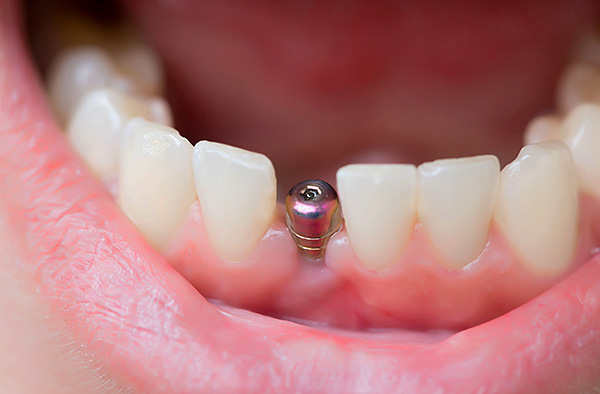
Today, dental implantation in many clinical cases is the most aesthetic, convenient and durable option for prosthetics of lost teeth. This is true both with the loss of 1-2 teeth, so with the restoration of the entire dentition.
Nevertheless, practice shows that not all people rush to an implantologist's appointment, often considering a more affordable alternative as a replacement for expensive implants - for example, bridges, partial or full dentures, or even use a temporary denture for years a butterfly.
Here is the denture on the implant:
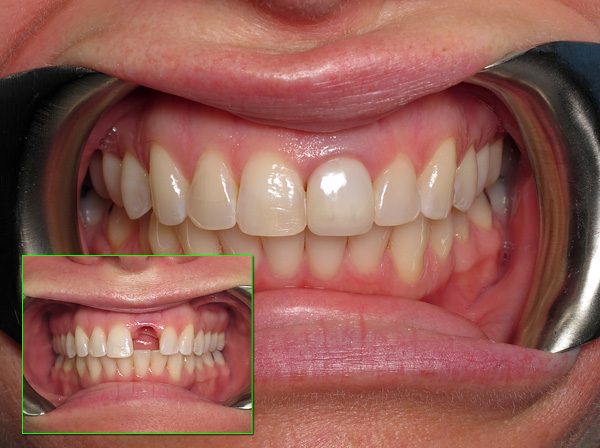
And below the photo shows prosthetic butterfly (in fact, this is a temporary prosthesis, however, many people use it as a permanent):
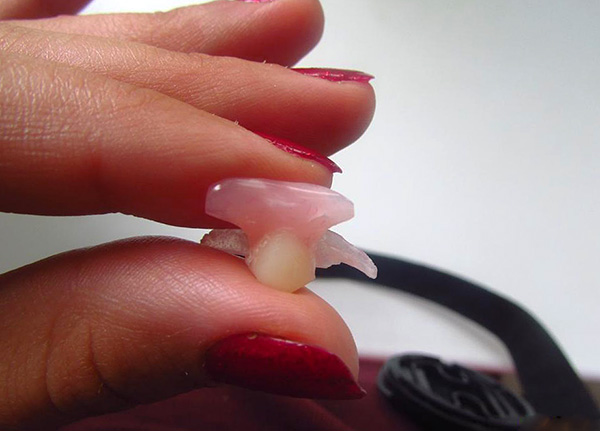
The main problem is the relatively high cost and complexity of installing dental implants - you need to cut the gum, drill the bone, then wait for the engraftment of the installed titanium “screw”. And the logical question that worries patients is how much will it cost?
In advertisements of various dental clinics today one can often find inviting actions of approximately this kind: implantation of turnkey teeth - only 30 thousand rubles per 1 tooth. But what exactly is included in this price? Does the cost include anesthesia, CT scans, bone tissue, abutment, crowns?
In practice, depending on the clinical case, the total amount for treatment can reach impressive values. Here is an example of a review left on this site for an article about dental implants for periodontal disease:
“5 years ago, the gums began to bleed. I went to the dentist, he advised me to buy a rinse aid. At the same time, the already exposed tooth root was sealed. Every year I went to the dentistry with one problem - fillings fell out and bleeding gums. Until they came full tryndets. And now they offer implantation, the question price is 300-400 thousand. Moreover, all the scoundrels in white coats are not treated in urban dentistry, but they offer to go for a fee, where they themselves earn extra money (burn them in hell with a blue flame). ”
Sergei
Let's try to figure out what is usually included in the cost of dental implantation, how the prices for “turnkey” implants are formed and whether it is possible to know exactly before the start of treatment how much tooth restoration will cost ...
What is the cost of dental implants
To better understand what the total cost of dental implants can be, it is useful to have an idea of the main stages of this procedure. These include:
- Preparation for implantation;
- Surgical stage;
- Stage of osseointegration (engraftment) of the installed implant;
- And, finally, prosthetics on the implant itself (with the implantation technique with immediate loading, the prosthesis is installed almost immediately after the surgical stage, that is, a long wait for the implant to engraft in the bone is not required).
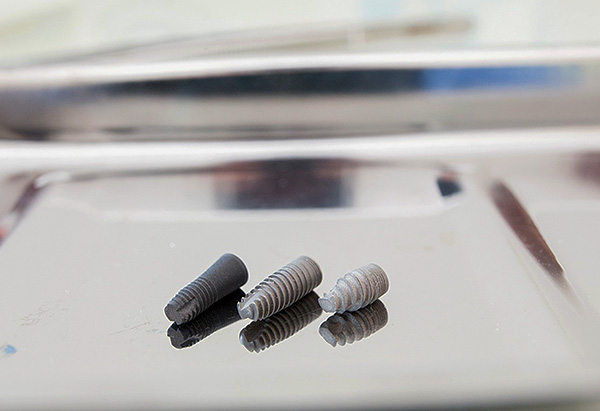
Next, we will analyze these stages in more detail, and also see what materials will be required for treatment.
Dental implant preparation
The first stage is critical not only for determining the course of the upcoming treatment, but also in relation to the formation of the cost of the entire procedure. It should be understood that until the doctor has performed an examination - all statements regarding the financial side of the issue are extremely approximate.
It all starts with an initial consultation with a doctor. In fact, the visit is limited to personal communication with the implantologist, as well as visual inspection of the oral cavity.The doctor needs to draw conclusions (even if only preliminary) - is it possible to carry out implantation, that is, are there any contraindications for health reasons. Be sure to tell the implantologist about possible health problems, especially not concealing serious diseases (for example, tumors, diabetes mellitus, hepatitis, disorders of the cardiovascular system).
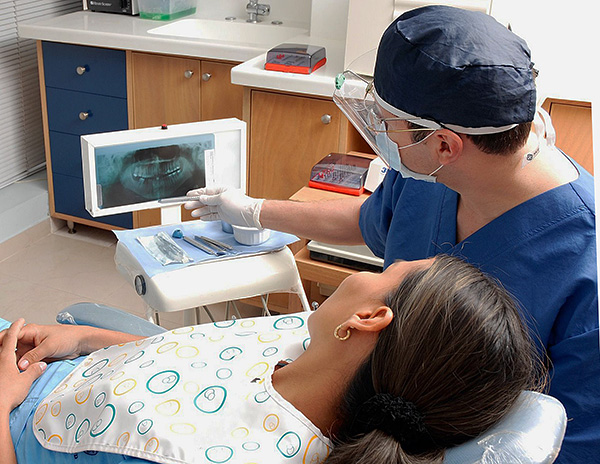
As a rule, the initial consultation with a doctor is free. At this stage, implant models can already be selected, after which a work plan is drawn up (an agreement is concluded on the basis of which the final implant price should be written).
If the patient is happy with everything, then a more thorough diagnosis of the state of the oral cavity is made. The main goal of diagnostic procedures is to study the condition of the jawbone: its volume and quality, the location of the maxillary (nasal) sinuses, and the mandibular nerve are important.
Accordingly, to assess the state of bone tissue can be carried out:
- X-ray of the area of one tooth;
- orthopantomogram - a panoramic image that covers one or both of the entire dentition;
- computed tomography (CT) scan, which allows you to get a three-dimensional, three-dimensional image of the jawbone (the most accurate diagnostic method).
This is what an orthopantomogram looks like:
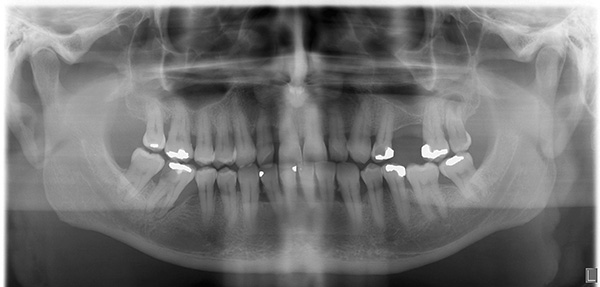
On a note
Equipment for computed tomography is not present in every dental clinic. Therefore, if necessary (the doctor will tell you about this), you will have to go to a different clinic - a dental or specialized one, where CT is performed.
CT of one jaw costs an average of 3,500 rubles., Two jaws - about 7,000 rubles.
Often you can get by with an orthopantomogram, the average cost of which is 700-1000 rubles.
It is worth considering the additional possible components of the preparatory phase, which are usually not included in the cost of tooth implantation "turnkey" and may require a separate payment. For example, you might need:
- treatment of teeth in poor condition (“rotten” teeth are breeding grounds for bacteria and pose risks for successful engraftment of implants);
- gum treatment;
- professional hygiene (plaque and stone removal).
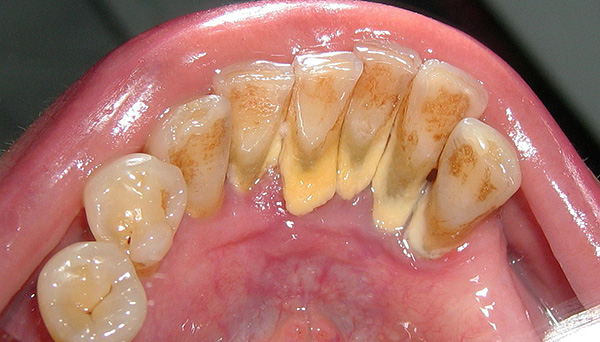
Inadequate oral hygiene can lead to inflammation of the tissues around the implant and its subsequent rejection. For this reason, the patient is advised to strengthen hygiene procedures at least 2-3 weeks before implant placement.
In addition, prior to implantation, it may be necessary extraction of one or more teeth. If we are talking about the classical method of two-stage implantation, then tooth extraction is an additional step that requires a separate payment (then several months must pass, during which the bone will recover, after which the implants can be installed). However, if the condition of the bone and the patient’s health as a whole allows for simultaneous implantation, then there is usually no need to pay separately for tooth extraction - this is part of the treatment in which the implant is immediately installed in a fresh hole where the tooth root was previously located.
If there are health problems, the implantologist can refer you to a general practitioner or specialist specialists, as well as for tests (blood, urine). In this situation, the patient is free to choose a doctor and a laboratory on his own, where an additional examination of the body will be carried out. Of course, this is also paid separately.
On a note
There are not so many absolute contraindications when implantation is not possible. Treatment may be refused in case of blood coagulation disorder, in the presence of certain mental illnesses, malignant tumors of any organs, serious immune system disorders, uncompensated diabetes mellitus, tuberculosis, and also masticatory hypertonicity.
Taking into account the data on the condition of the jawbone, gums and preserved teeth, the implantologist, when drawing up the plan for the upcoming treatment, determines the optimal place for each implant. As a rule, this is carried out using special wax models of the jaw. Taking casts and making such models is included in the cost of implantation.
Today, in advanced dentistry, computer software is increasingly used to plan the treatment process - CT data are downloaded to a computer, processed, and the program helps the doctor find the place for the implant, taking into account all the structural features of the jawbone of the patient. Additional payment for this service is not required, since it is already included in the cost of implantation, but such treatment will be relatively expensive.
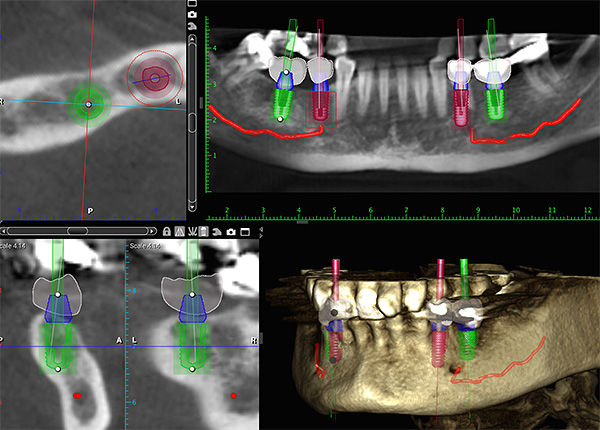
On a note
For example, Nobel Biocare (Switzerland) strongly recommends using its own software when installing its implants. Nobel implants belong to the premium category, and installing them on a turnkey basis costs about 80,000 rubles. per 1 tooth.
So, summing up the preliminary results regarding the preparatory phase, let's see the approximate prices for additional services that you may have to pay separately from the “turnkey” dental implants:
| Name of service | Estimated cost (Moscow) |
| The doctor's consultation | is free |
| X-ray of 1 tooth | from 250 rubles |
| Orthopantomogram of the entire jaw | from 1000 rubles |
| Computed tomography of the entire jaw (conducting + data decryption) | from 3500 rubles |
| Caries treatment 1 tooth | from 1500 rubles |
| Pulpitis Treatment 1 tooth | from 3000 rubles |
| Ultrasonic toothbrushing - removal of deposits | from 2500 rubles |
| 1 tooth extraction | from 2500 rubles |
Dental implant cost
A significant contribution to the cost of dental implantation is made by the cost of the implant itself (that is, in fact, a titanium “screw”).
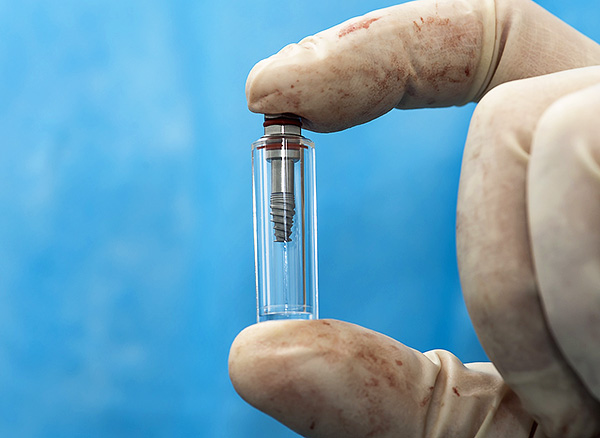
The following are indicative data on the cost of the most popular implant brands at the beginning of 2019:
| Implant brand | Estimated cost, rub. |
| Alpha BIO (Israel) | 6000 |
| MIS (Israel) | 7000 |
| Snucone (Korea) | 7000 |
| BioHorizons (USA) | 10 000 |
| AstraTech (Sweden) | 15 000 |
| XiVE (Germany) | 20 000 |
| Ankylos (Germany) | 20 000 |
| Nobel biocare | 25 000 |
| Straumann | 25 000 |
Surgical stage and subsequent implant implantation
It is clear that the work of the implant surgeon and the accompanying accompaniment of the entire treatment process by him is not a free service for the patient. Moreover, the higher the qualification of the doctor and the status of the clinic, the usually higher you have to pay for it - all these nuances are already included in the final price.
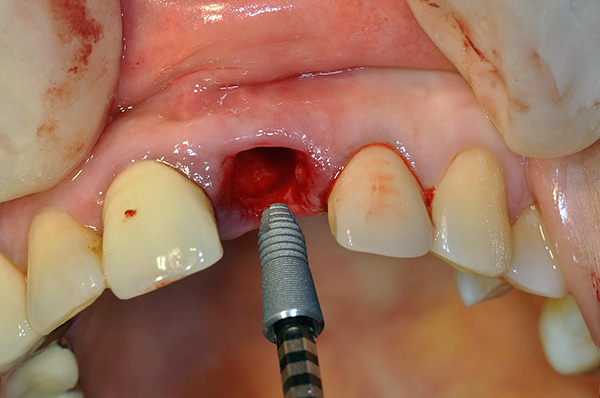
The operation to install the implant itself takes no more than an hour and is carried out as follows: the gum is cut, its small flap is peeled off, which allows access to bone tissue. Using special burs and cutters, a hole is formed in the bone - the bed under the implant. Then the implant is screwed into the bone (as a self-tapping screw) and closed with a plug. The gingival flap returns to its place and is sutured - sutures are applied.
In the classical two-stage implantation technique, several months must elapse after implant placement, before you can proceed to the stage of permanent prosthetics (of course, you don’t have to go without teeth - for this period the patient will be offered temporary removable dentures, the manufacture of which, by the way, will have to be paid separately) .
On the lower jaw, the duration of fusion of the implant and bone takes about 2-4 months, on the upper - 4-6 months. During this time, you must regularly visit your doctor (the first time - 3-7 days after surgery, after - another 2-3 times). This is exclusively required. for the prevention of complications - with regular examinations, the implantologist will be able to control the quality of implant engraftment and, in case of any problems, eliminate them at an early stage.
On a note
Dental implantation is performed under local anesthesia - this is enough for a painless operation. However, in a number of cases general anesthesia can also be used (but only if there is really evidence for anesthesia - for example, a dentist’s panic fear or allergic reactions to anesthetic components).
The cost of “turnkey” dental implantation does not include bone grafting - a surgical procedure that is not so rarely required by patients when installing implants. For example, a kind of bone grafting is sinus lifting - in case of atrophy of bone tissue in the upper jaw (a decrease in the volume of the jaw bone occurs with a long absence of teeth). Simply put, so that the titanium implant, when screwed into the bone, does not pierce the maxillary sinus wall and holds firmly, it is necessary to increase the volume of bone tissue at the site of implant placement.
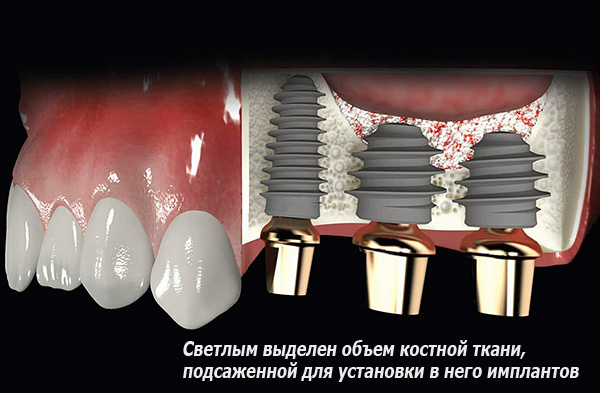
Bone grafting may also be required on the lower jaw. Implantation of artificial bone material or autologous bone block transplantation can be used (in the latter case, a small part of the bone is borrowed from the patient himself - usually from the zone of wisdom teeth).
The listed operations are paid separately. It is worth noting that they are quite expensive (usually cost more than 10,000 rubles.). In addition, they can delay the process of dental implantation - after bone growth, as a rule, at least 3-4 months should pass, because the injured tissue must be completely restored. Only after the end of the regeneration process are implants installed.
Another operation that may also be required during implantation is gum repair. Violation of the position of the contour of the soft mucosa occurs simultaneously with atrophy of the bone tissue - the bone sags, moreover, unevenly along the entire dentition, and the gum along with it. That is why there may be a need for surgical repair of the gums, the purpose of which is to restore the aesthetics of the mucosa. Gum repair is also paid extra.
And here is an approximate price level for these surgeon services:
| Name of service | Estimated cost, rub. |
| Sinus lifting open | from 25 000 |
| Sinus lifting closed | from 10 000 |
| Bone block autotransplantation | from 40 000 |
| Artificial bone grafting | from 35 000 |
| Gingival plastic (1 jaw) | from 15 000 |
As you can see, even if the advertisement of a clinic indicates the cost of a “turnkey” dental implant of 20,000 rubles. - This does not mean at all that upon closer examination of a specific clinical situation it will be possible to manage with such an amount.
Final implant prosthetics
It would seem that after installing the implant, it is enough to wait for its engraftment, then make a prosthesis and fix it on the implant. Everything is simple. In general, everything is the way it is, but in fact these stages may not seem so simple and insignificant (including financially).
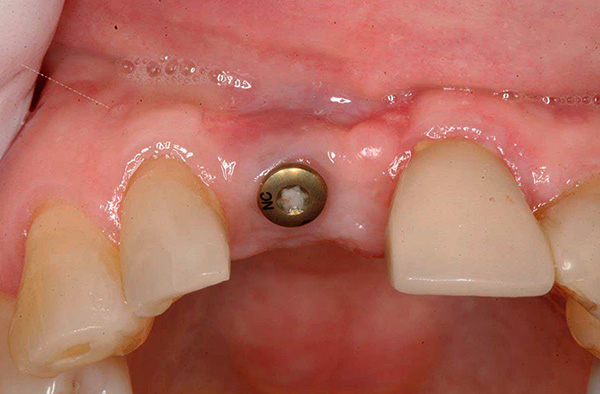
Here are some procedures you will need:
- Taking impressions after implant placement, manufacturing and fixation of a temporary prosthesis (so as not to go without teeth for almost half a year);
- After successful implant engraftment - repeated gingival incisioncovering the stub on the implant, removing the stub and fixing the healing abutment (performed 2-3 weeks before the installation of a permanent prosthesis). The gingiva former allows you to adjust the position of the soft mucosa around the future crown;
- Removing the gingiva former and replacing it with an abutment (an element that serves as the basis for the prosthesis), installing it on the abutment and fitting a permanent prosthesis made in advance of the casts.
The listed manipulations are already included in the cost of implantation. But the abutments deserve special attention - these are the elements that connect the intraosseous part of the implant and the crown.
The abutment model is selected at the stage of treatment planning.Therefore, the price of the abutment itself will be included in the cost of the entire treatment, but it can vary markedly (for example, a simple abutment can cost 1,500 rubles, and an individual one from zirconium dioxide can cost 10,000 rubles).
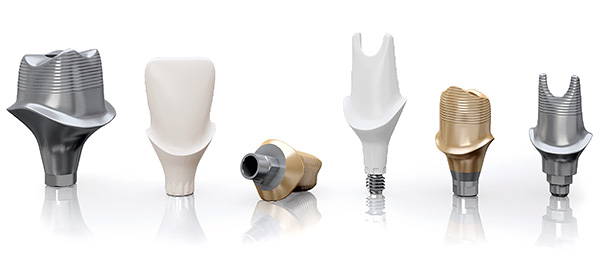
Let's see what abutments manufacturers produce today:
- Classic titanium - are created from the same material as the dental implants themselves. They are opaque, therefore it is better not to use such abutments with translucent zirconia crowns, as they can be seen in the light;
- Zirconia abutments - have a white color, which allows to achieve the best aesthetics. The material is not inferior in reliability and durability to titanium;
- Individual abutments can also be created from zirconium dioxide, but they do not have a stencil shape, but are adapted to the clinical situation of a particular patient.
As for the prostheses themselves, here patients have a fairly large selection. Permanent or semi-removable structures can be fixed on implants (the possibility of removal remains, but there is no need to do this every day).
It is interesting
To restore 1-2 teeth, single tooth crowns are used, for 3 or more - bridges, which consist of interconnected crowns. Conditionally removable dentures are recommended to replace about half or all of the dentition. In addition to crowns, their construction also has a plastic base - an artificial gum. It is less massive than in removable dentures, since its function is not to fix the structure in the oral cavity, but to cover the gum, the aesthetics of which are impaired due to atrophy of the bone tissue. In addition, when restoring the entire dentition, such prostheses are 2-3 times cheaper than installing dental bridges, including due to the fact that there is no need to perform gum repair.
Dental crowns mounted on implants can also vary greatly in price:
- Plastics crowns - used as a temporary option. They are inexpensive, they can be easily relocated and even repaired directly in the patient’s oral cavity (and this may be necessary, since the bite may change a little at the first time after implant placement). Metal-plastic crowns can last 3-5 years;
- Cermet crowns are a more expensive option for permanent prosthetics. They are distinguished by a sufficiently high strength and good appearance, but in the case of using cobalt-nickel base they can cause allergic reactions. The service life of ceramic-metal crowns on implants is about 12-15 years;
- Zirconia crowns are the most expensive, but also the most durable and advantageous in terms of aesthetics. They can last more than 20 years without problems. Ideal for restoration of the front teeth, because, unlike cermets, they do not have a dark base. But processing zirconia requires special equipment (crowns are created by computer simulation and subsequent robotic milling), so their cost is high.
Zirconia crowns are shown in the photo below:
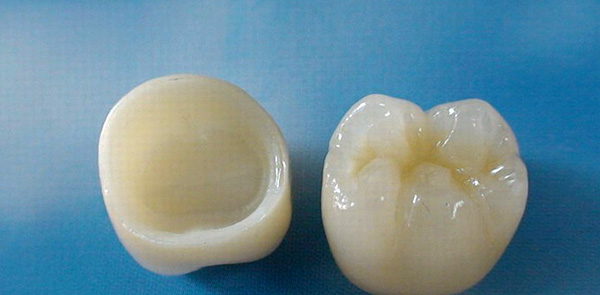
Here is an approximate price level for crowns and abutments:
| Denture material | Estimated cost, rub. |
| Temporary crown on the implant - 1 tooth | from 2500 |
| Temporary removable denture prosthesis | from 6000 |
| Ceramic-metal crown for 1 tooth | from 3000 |
| Zirconia crown for 1 tooth | from 6000 |
| Titanium Abutment * | from 1100 |
| Zirconia Abutment | from 4500 |
| Individual Abutment | from 7500 |
* The cost of abutments is highly dependent on the manufacturer - the more expensive the implant itself, the higher the cost of suprastructures.
The effect of the implantation method on the cost of treatment
Today, there are two main directions for tooth restoration through implantation: This is a classic (two-stage) protocol and a set of express methods.For express methods, the number of treatment steps is less, which sometimes saves several tens or even hundreds of thousands of rubles.
The first method of rapid implantation is simultaneous implantation. It is carried out simultaneously with tooth extraction (while the classical approach implies a long restoration and healing of the bone after such a procedure). With a one-stage technique, the implant is installed in a fresh hole (unfortunately, this is not always possible, especially against the background of inflammatory processes, when the tooth has to be removed urgently). With this approach, the treatment process is reduced by one stage, which means saving time and money.
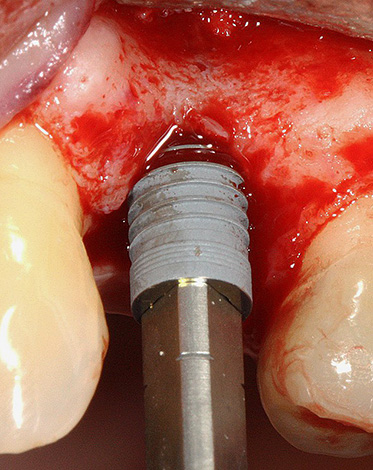
The second option is immediate loading basal implantation. In 90% of cases, it allows to do without bone growth, since implants are installed even at an angle, bypassing atrophied sections of the bone (this is not possible with the classical approach). In addition, there is no need for long-term wearing of removable prostheses - the fixed structure made of metal-plastic is fixed almost immediately on the implants, the prosthesis “connects” all the implants into a single whole and stabilizes them - you can chew food with new teeth in a day or two, without fear of damaging just mounted titanium "screws".
On a note
A prosthesis with artificial teeth made of metal-plastic will last 2-3 years, and after that it will need to be replaced with a permanent structure with teeth made of cermet or zirconium dioxide. When choosing this technique for restoring all teeth, the cost of “turnkey” implantation is almost 2 times lower than the classical version.
It should be noted that implantation with immediate loading can also be performed on classical (non-basal) implants, if this allows the condition of bone tissue to be made.
In the absence of teeth, the All-on-4 and All-on-6 techniques may be of interest, that is, complete prosthetics of the teeth on both jaws on 4 or 6 implants, respectively. This approach allows you to save 2 -2.5 times compared with the classical method. See more about these techniques in a separate article: All-on-4 and All-on-6 dental prosthetics technologies.
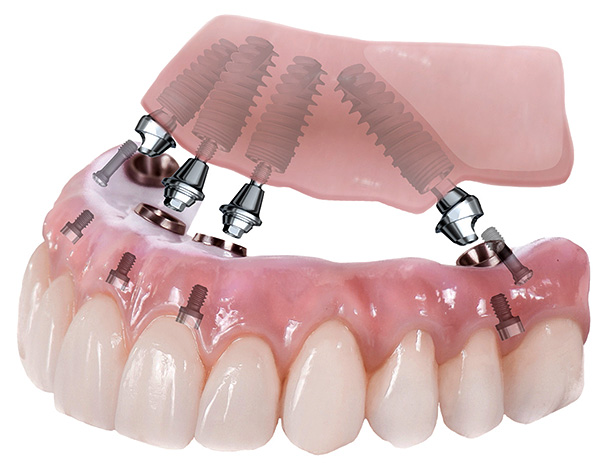
It is also worth mentioning the so-called mini-implantation, which uses rather miniature thin implants MDI (mini dental implants). They are established by puncture of tissues, without gum cuts, that is, without the need for a long recovery. However, these structures can only be loaded with removable dentures - they simply can not withstand a large load.
On a note
It should be borne in mind that mini-implants do not provide the proper load on the bone tissue, and its atrophy continues. Therefore, over time, both the implants themselves and the prosthesis will shift.
How much will the restoration of the entire dentition with implants cost?
In the treatment of complete adentia, that is, when all the teeth are missing in the oral cavity, there are a number of nuances.
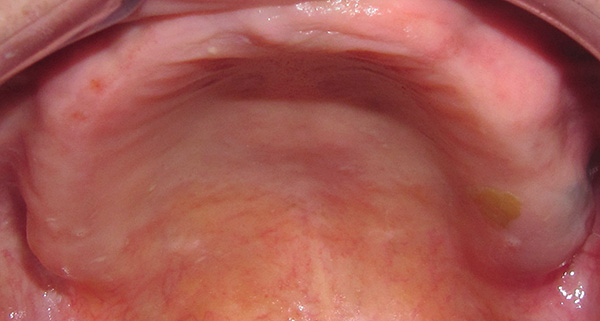
Firstly, when restoration of a complete dentition can be used from 4 implants. This allows you to significantly save and also facilitate rehabilitation for the patient (it’s quite difficult to withstand the installation of a large number of implants on two jaws in a short period of time, because under each one you need to cut the gum and drill the bone).
It is interesting
As noted above, today, with full adentia, the All-on-four technology is actively used, which means "all four." That is, the prosthesis is mounted on only 4 implants, and according to the technique with immediate loading. The first two implants are fixed in the area of the anterior teeth strictly vertically, 3 and 4 implants - in place of 4-5 teeth at an angle of 45 degrees. After 2-3 days, a metal-plastic prosthesis is attached to the implants (it can be either a bridge or conditionally removable with a small part of the artificial gum).
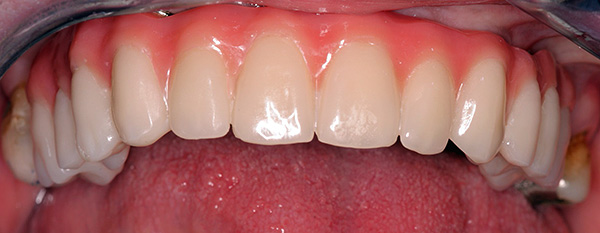
Secondly, with a full prosthetics, you can save on additional procedures such as bone tissue and gum repair. This is possible if a basal implantation technique is chosen, in which the implants can be fixed even with significant bone atrophy and without mucosal plasty.
Thirdly, there is a choice regarding conditionally removable full dentures, which, depending on the materials used in their manufacture, can vary significantly in price.
And here is an approximate price level for a complete denture using different methods:
| Technology | Estimated cost, rubles |
| All-on-four (+ conditionally-removable denture on one jaw fixed on 4 implants), Alpha BIO | about 130,000 |
| All-on-four (+ conditionally-removable denture on one jaw fixed on 4 implants), NOBEL | about 450,000 |
| Mini implant prosthetics (removable denture) | about 130,000 |
| Basal implantation with immediate loading of the prosthesis (6-8 implants + non-removable metal-plastic denture) | about 300,000 |
| Classical implantation with a delayed prosthesis load (6-8 implants + fixed denture) | about 500,000 |
So what is included in the "turnkey implantation"?
When the advertisement says about the "turnkey" implantation of a tooth (or teeth), one may get the feeling that the patient must pay once and only the amount indicated in the price list for this service. However, in view of the above, it is quite obvious that in fact everything may not be as rosy and cheap as it sometimes seems at first glance.
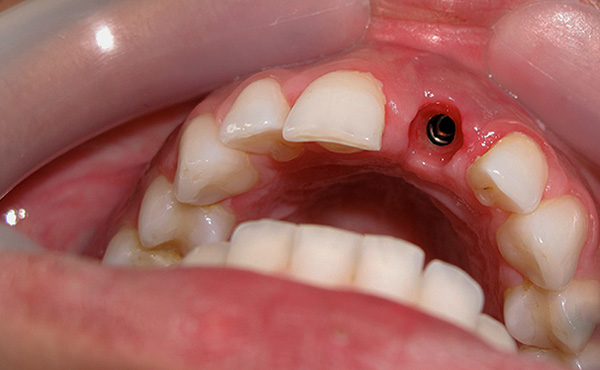
Feedback:
“I bought an advertisement that you can install turnkey dental implants very inexpensively - for 25 thousand rubles and all inclusive. The huge contract, of course, did not read thoroughly. As a result, it turned out that I had to carry out a bunch of additional procedures - to heal 2 teeth, implant the bone, plus they sent to CT to another clinic! I paid exactly 57 thousand for all the treatment. So much for everything ... ”
From forum posts
The following is a list of services that, as a rule, are already included in the cost of installing a “turnkey” implant, as well as the services for which you usually have to pay separately:
| Name of service | Is the service included in the turnkey price |
| Initial consultation with a doctor, visual examination | + |
| Diagnostics (X-ray, orthopantomogram, CT) | + |
| Computer simulation of the treatment process | + |
| Installing the implant, plug and healing abutment | + |
| Setting a standard abutment | + |
| Temporary prosthetics: casting, making and fixing the prosthesis | + - (extra charge is sometimes required for a temporary prosthesis) |
| Permanent prosthetics: taking impressions, removing a temporary prosthesis, fixing a permanent structure | + - (not always the cost of the crown is included in the price) |
| Regular preventive examinations of the doctor throughout the whole time of implant engraftment | + |
| Warranty | + |
| Blood, urine tests, consultation of narrow specialists | — |
| Dental and gum treatment | — |
| Tooth extraction | + - (often the cost of tooth extraction is not included in the price) |
| Surgical procedures: bone extension, gum repair | — |
| Surgical Template Development | — |
On average, restoration of one tooth on an inexpensive implant (for example, Israeli Alfa Bio) with a ceramic-metal crown will cost about 35,000 thousand rubles. If atrophy of bone tissue is observed and gum aesthetics is impaired, then the cost of treatment will increase to 50-60 thousand rubles. Restoring the entire dentition on 4 implants will cost at least 150 thousand rubles for all procedures, including the installation of a prosthesis.
Some practical tips on how to avoid overpaying for dental implants
Already during the first communication with the doctor (and consultations in many clinics are usually free), be sure to ask the implantologist what procedures will be required in your case and how much they cost - so that later this does not become an unpleasant surprise.Having data on prices for related services in different clinics, it will be easier to make a choice based on your financial capabilities.
Carefully read the contract - it should reflect all the agreed procedures, as well as clearly indicate the total amount for treatment.
Do not chase too cheap, trying at all costs to choose only the cheapest option. In the case of dental implants, excessive cheapness can mean significant costs in the future (this will become clear when the implant of a little-known “Chinese” company suddenly starts to be rejected).
First of all, try to focus on choosing a good doctor, and not one or another implant. A professional who is responsible for work will advise the best implant system for your case and will make every effort to ensure that the installed implants last for several decades without problems.
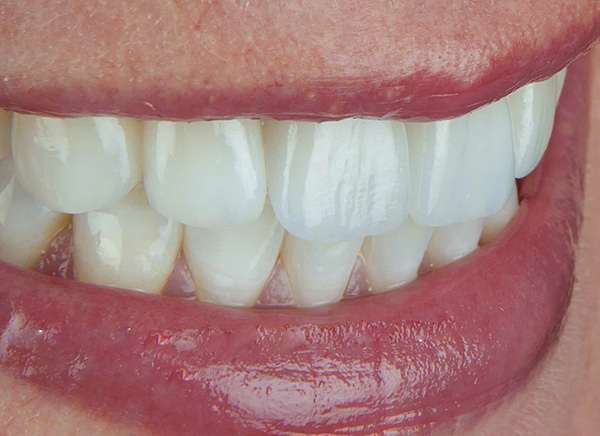
Track promotions that are often held in dental clinics. Sometimes, taking advantage of a good offer on time, you can save up to 20-30% of the original price.
If you have personal experience in installing dental implants (or just planning) - share information: have any pitfalls (additional services requiring financial costs) been revealed, what amount has the clinic indicated, and in general, how is your situation? Any information on this topic is welcome.
How much is dental implantation today and what does it depend on
Useful video with answers to frequently asked questions about dental implants

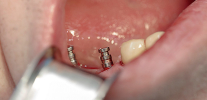
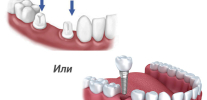

Hello, I don’t know which implant is better to choose for the lower 6. In the clinic, these options are available for selection: Alpha Bio, Straumann, Osstem. In terms of finances, you can choose any one, but you also don’t want to overpay unnecessarily for a brand. What advise option?
Hello. If possible, it is better to choose a premium segment implant system, in your case the Straumann implant system will be the most suitable, since the statistics of engraftment and service life on premium implants are much better. For example, our clinic provides a lifetime warranty and free after-sales service for this implant system.
12 years ago I had a tooth removed. Now is there still an opportunity to put an implant or is a prosthesis better?
Hello, Michael. There is no time limit for implant placement after tooth extraction. The implantologist will diagnose the volume of bone tissue, and then determine the optimal method of treatment.
Is it possible to put 1 implant instead of two chewing teeth on the lower jaw, instead of the last and penultimate tooth?
Hello Andrey! In this situation, it is not possible to install two crowns on one implant, so one implant will replace one tooth. At the first stage, restoration of one tooth is possible, but in any case it is highly desirable to restore the second one.
Hello! I do not have three teeth on the upper jaw. The clinic offers to install two implants and one crown. But I have doubts, they suddenly will not take root, and the amount is considerable.
I would like to install three implants, but not all at once, but to do it in stages. First one, then a few months later the second and then the third. I understand that this will stretch for a long time, but then each tooth will be on its own. In addition, you do not have to pay immediately a large amount, you can pay in stages. Alternate implant placement - is it worse than all at once, or is there no difference?
Hello Paul. Answering your question, I want to note right away that of course there is a difference! Technically, of course, you can do the way you want, under certain conditions: the volume of bone tissue, the condition of the antagonists, whether you will wear a temporary denture or not, in which area there are no teeth, etc. I recommend installing all implants at once. In addition, there is a recommendation from implant manufacturers that it is preferable not to make the teeth on the implants separately, but to connect them together in bridges. Especially if it is a chewing group of teeth.
Phased treatment is several operations, each time an incision, swelling, antibiotics, discomfort in the area of the operation. Plus bone atrophy. And in the end, reaching the third implant, you can encounter new problems in the form of a lack of bone tissue.
Good afternoon! I have both upper sixes treated with the resorcinol method. Now there are blackouts on the tops of the roots, the doctor advises me to remove these teeth and put implants in their place.
Tell me, is it possible to save such teeth, just treat the canals?
Hello Marina. It all depends on the condition of the remaining tooth tissues, as well as on how large the lesion is at the top of the roots. If the tooth has maintained its integrity and the focus is small, then treatment can give a positive result. In such a situation, it is useful to get the opinion of several dentists in an in-person consultation.
Hello. I had a dead tooth on top, recently a large chunk broke off from it while eating. I went to two clinics. In one, the doctor said that you can put a crown. In the second they say that only an implant will help here. Why do doctors say different things and what to do?